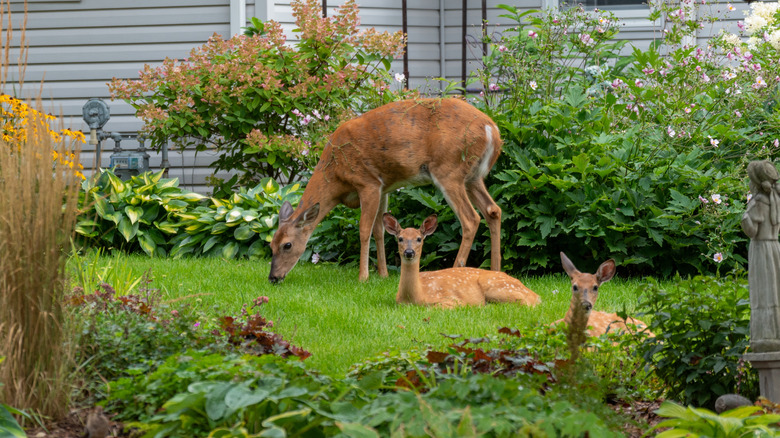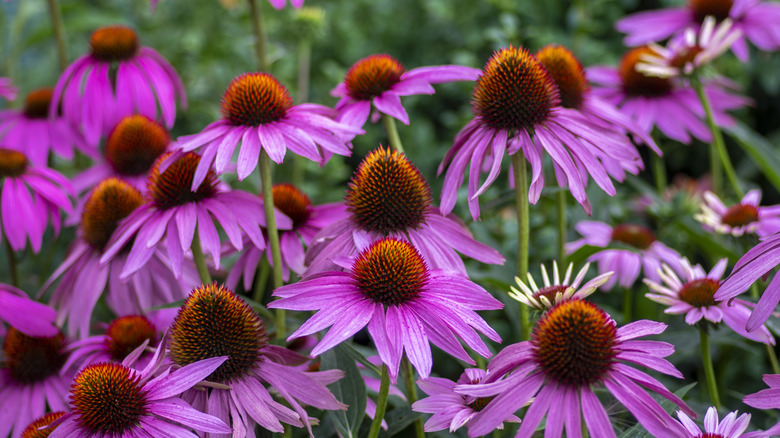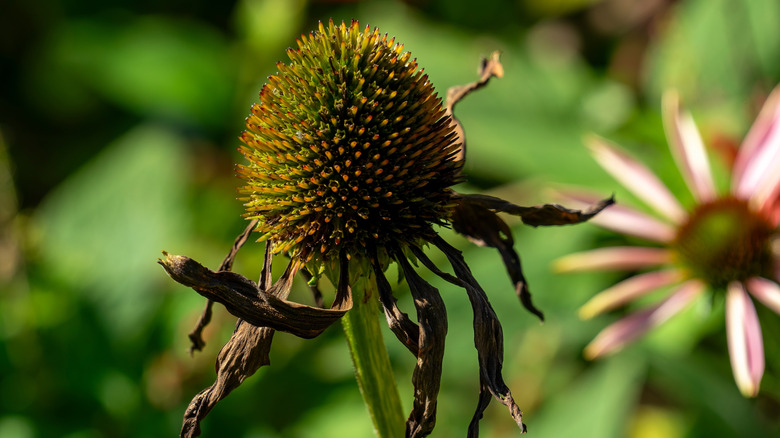Add Color To Your Garden While Deterring Deer With A Popular Flower They Hate
It's hard to enjoy a garden when it doubles as a midnight buffet for deer. One day your flowers are blooming, and the next they're stripped to stubs — leaves torn, stems snapped, and petals gone without a trace. In many parts of the U.S., growing a lush, colorful yard has become a constant battle against deer, especially as their numbers continue to rise and food sources grow scarce. That is why so many gardeners turn to purple coneflowers (Echinacea purpurea).
These bright, daisy-like perennials are known not just for their cheerful colors and long bloom time, but also for how rarely deer bother them. While no plant is completely deer-proof, coneflowers come close. Their rough leaves are coarse and hairy, and the spiny seed heads make for an unpleasant bite. On top of that, coneflowers release a strong, herbal scent that deer don't seem to enjoy. For deer, that combination of sharp smell and scratchy texture is enough to send them elsewhere.
Simple tips to help your coneflowers thrive
Coneflowers are low-maintenance perennials that offer consistent color without constant upkeep. They're hardy in USDA Hardiness Zones 3 through 9 and can handle a wide range of seasonal weather — from late spring chills to hot, dry summers. For the healthiest growth and most vibrant blooms, choose a spot that gets six to eight hours of direct sun each day. These plants prefer soil that drains well and holds steady moisture without staying wet.
Loamy soil works best, but coneflowers can also grow in sandy or slightly clay-heavy conditions, as long as excess water doesn't pool around the roots. After planting, these flowering perennials establish quickly and rarely need special attention. Give each plant 12 to 24 inches of space to allow airflow and reduce the chance of fungal issues like powdery mildew. You can plant them in spring or fall, and once they take root, they'll return each year and slowly spread. Every few years, divide mature clumps in the fall to keep them vigorous and prevent overcrowding.
Deadheading spent blooms can encourage more flowers, but it's optional. In fall or winter, you can cut the stems back or leave them standing to feed birds. Coneflowers also attract a steady stream of pollinators, including bees, butterflies, and hummingbirds. Adding them to your garden helps support local pollinator activity, especially during their peak blooming period in summer.
Coneflowers still have enemies
While deer usually steer clear of coneflowers, rabbits are a different story — especially when the plants are young. New growth is soft and easy to bite through, which makes seedlings and fresh shoots an easy target. If you've had problems with rabbits in your garden before, it's worth protecting new plants early on. You can surround them with mesh or garden fencing, or spray the foliage with something that makes it less tasty, like a hot pepper-based repellent.
Insect pests can also show up once the weather warms up. Aphids are one of the most common. They cluster on stems and buds, sucking sap and weakening the plant. Sweet potato whiteflies tend to stay hidden under the leaves, where they draw out the plant's juices and weaken overall growth. Their feeding often leads to yellowing or torn-looking leaves, and the sticky residue they leave behind can trigger black mold to form on the surface. These pests also carry plant viruses, which can contribute to coneflower diseases if not controlled early.
Japanese beetles are one of the more destructive pests you might see on coneflowers. They tend to arrive in early summer and often appear in clusters. These beetles target both leaves and blooms, eating through the plant from the top down. Their feeding can leave flowers ragged and foliage full of holes in just a few days. If you catch them early, removing them by hand is usually effective. It also helps to prune off any badly damaged parts so the plant can focus its energy on healthy growth.


